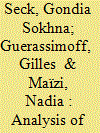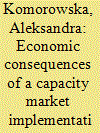|
|
|
Sort Order |
|
|
|
Items / Page
|
|
|
|
|
|
|
| Srl | Item |
| 1 |
ID:
150792


|
|
|
|
|
| Summary/Abstract |
A large number of studies have been conducted on the contribution of technological progress and structural change to the evolution of aggregate energy intensity in the industrial sector. However, no analyses have been done to examine theses changes in the non-energy intensive industry in France. We analyzed their importance in French industry with respect to their energy intensity, energy costs, value added, labour and the diffusion of production sites by using data at the 3-digit level with 236 sectors. Using a new decomposition method that gives no residual, this paper attempted to examine, over 10 years from 1996 to 2005, the changes that occurred in an area that has been neglected in energy analysis. We found that structural change had an overwhelming effect on the decline of aggregate energy intensity. Furthermore, we found that the higher the level of sector disaggregation, the more significant the changes that can be attributed to structural change, due to the homogeneity of this industrial group. The results of our study show that it is important to take into account the effects of structural change in “bottom-up” modelling exercises so as to improve the accuracy of energy demand forecasting for policy-makers and scientists.
|
|
|
|
|
|
|
|
|
|
|
|
|
|
|
|
| 2 |
ID:
176783


|
|
|
|
|
| Summary/Abstract |
The paper examines the interactions between nuclear and variable renewable generation capacities (vRES) under various assumptions in the broader V4 region. Four exploratory scenarios are analysed with high and low penetration levels of vRES and nuclear applying electricity dispatch and unit commitment models. The assessment quantifies the impacts of the joint evolution of these technologies, measuring the effect on utilisation rates, wholesale prices, market values of vRES, energy not supplied (ENS) and the changing production and trading patterns in the projected 2035 electricity system. The results are indicative of a ‘double competition’ between (i) nuclear and vRES technologies within the merit order and (ii) between the NPPs in the region. If the ambitious V4 nuclear plans are indeed execute, NPPs will compete for limited export opportunities during times of high vRES production periods. Thus, coordination of long term energy policies within the V4 region is critical to manage nuclear and vRES developments and trade patterns with the aim of improving flexibility and security of supply to mitigate the negative economic impact on the electricity system.
|
|
|
|
|
|
|
|
|
|
|
|
|
|
|
|
| 3 |
ID:
119793


|
|
|
|
|
| Publication |
2013.
|
| Summary/Abstract |
Most modelling studies that explore emission mitigation scenarios only look into least-cost emission pathways, induced by a carbon tax. This means that European policies targeting specific - sometimes relatively costly - technologies, such as electric cars and advanced insulation measures, are usually not evaluated as part of cost-optimal scenarios. This study explores an emission mitigation scenario for Europe up to 2050, taking as a starting point specific emission reduction options instead of a carbon tax. The purpose is to identify the potential of each of these policies and identify trade-offs between sectoral policies in achieving emission reduction targets. The reduction options evaluated in this paper together lead to a reduction of 65% of 1990 CO2-equivalent emissions by 2050. More bottom-up modelling exercises, like the one presented here, provide a promising starting point to evaluate policy options that are currently considered by policy makers.
|
|
|
|
|
|
|
|
|
|
|
|
|
|
|
|
| 4 |
ID:
176859


|
|
|
|
|
| Summary/Abstract |
This paper investigates the potential economic consequences of setting up a capacity market in Poland. A computable model of the Polish power generation system is developed and employed to analyse the impact of this mechanism. Two scenarios are designed for this study: (i) a reference scenario that reflects the energy-only market and (ii) a capacity market scenario that assumes the implementation of such an instrument. To assess the economic consequences, the following parameters are estimated: (i) annual electricity prices, (ii) Loss Of Load Hours, (iii) Expected Energy Not Served, and only for the capacity market scenario: (iv) market clearing price, (v) total budget of the capacity market, and (vi) increase in electricity price due to the introduction of the capacity market. The findings of the study indicate that the long-term maintenance of the energy-only market results in higher electricity prices when compared to putting a capacity market into operation. Introducing a capacity market enables existing resources to be used effectively without excessive capital expenditure. The methods and conclusions presented in this paper provide valuable findings and policy insights regarding the potential economic consequences of a capacity mechanism in a power system mostly dominated by coal and undergoing an energy transition.
|
|
|
|
|
|
|
|
|
|
|
|
|
|
|
|
| 5 |
ID:
094827


|
|
|
| 6 |
ID:
113426


|
|
|
|
|
| Publication |
2012.
|
| Summary/Abstract |
Long-term scenarios generally project a steep increase in global travel demand, leading to an rapid rise in CO2 emissions. Major driving forces are the increasing car use in developing countries and the global growth in air travel. Meeting the 2 °C climate target, however, requires a deep cut in CO2 emissions. In this paper, we explore how extensive emission reductions may be achieved, using a newly developed travel model. This bottom-up model covers 26 world regions, 7 travel modes and different vehicle types. In the experiments, we applied a carbon tax and looked into the model's responses in terms of overall travel demand, modal split shifts, and changes in technology and fuel choice. We introduce two main scenarios in which biofuels are assumed to be carbon neutral (not subject to taxation, scenario A) or to lead to some greenhouse gas emissions (and therefore subject to taxation, scenario B). This leads to very different outcomes. Scenario A achieves emission reductions mostly through changes in fuel use. In Scenario B efficiency improvement and model split changes also play a major role. In both scenarios total travel volume is affected only marginally.
|
|
|
|
|
|
|
|
|
|
|
|
|
|
|
|
| 7 |
ID:
110716


|
|
|
|
|
| Publication |
2011.
|
| Summary/Abstract |
Energy use in developing countries is heterogeneous across households. Present day global energy models are mostly too aggregate to account for this heterogeneity. Here, a bottom-up model for residential energy use that starts from key dynamic concepts on energy use in developing countries is presented and applied to India. Energy use and fuel choice is determined for five end-use functions (cooking, water heating, space heating, lighting and appliances) and for five different income quintiles in rural and urban areas. The paper specifically explores the consequences of different assumptions for income distribution and rural electrification on residential sector energy use and CO2 emissions, finding that results are clearly sensitive to variations in these parameters. As a result of population and economic growth, total Indian residential energy use is expected to increase by around 65-75% in 2050 compared to 2005, but residential carbon emissions may increase by up to 9-10 times the 2005 level. While a more equal income distribution and rural electrification enhance the transition to commercial fuels and reduce poverty, there is a trade-off in terms of higher CO2 emissions via increased electricity use.
|
|
|
|
|
|
|
|
|
|
|
|
|
|
|
|
| 8 |
ID:
115641


|
|
|
|
|
| Publication |
2012.
|
| Summary/Abstract |
Informed energy decision making requires effective software, high-quality input data, and a suitably trained user community. Developing these resources can be expensive and time consuming. Even when data and tools are intended for public re-use they often come with technical, legal, economic and social barriers that make them difficult to adopt, adapt and combine for use in new contexts. We focus on the promise of open, publically accessible software and data as well as crowdsourcing techniques to develop robust energy analysis tools that can deliver crucial, policy-relevant insight, particularly in developing countries, where planning resources are highly constrained-and the need to adapt these resources and methods to the local context is high. We survey existing research, which argues that these techniques can produce high-quality results, and also explore the potential role that linked, open data can play in both supporting the modelling process and in enhancing public engagement with energy issues.
|
|
|
|
|
|
|
|
|
|
|
|
|
|
|
|
|
|
|
|
|